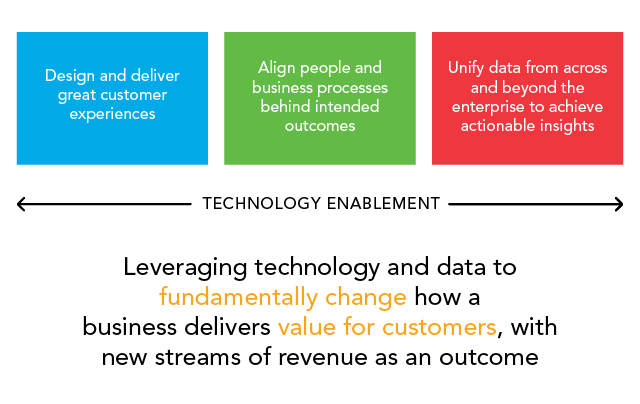Digital transformation is one of the business world’s most misconstrued concepts. But if it doesn’t mean getting a new marketing stack or moving from carbon paper to Excel, what does it mean?
In the fifth episode of Inside the Funnel, Jenna, Nasser, and Dan explored and explained why digital transformation is about customer experiences and business outcomes—not just shiny new tech. These are their top three takeaways, so let’s get to it. Podcast rewind—roll out!
-
What it is (and what it isn’t)
Let’s start by opening Jenna’s Big Buzzword Dictionary and flipping to her digital transformation definition: “Digital transformation is fundamentally changing how your business develops its plan, its processes, and its value to customers”. That makes it a process that is by its nature omnichannel and customer-centric; using tech to power a comprehensive overhaul and rethink of the business.
But here’s the kicker: the tech itself is not the transformation. Want to deploy a fancy new marketing stack but keep your core business otherwise unchanged? Then that’s not digital transformation, which would instead focus primarily on customer experiences, business outcomes, and how each can enhance the other.
-
The three pillars of digital transformation
Digital transformation—or simply recognizing the need for it—is often the result of a business noticing that its customers are navigating the world differently. Now that the reality of the “last best experience” is firmly understood, brands have their work cut out to cater to customers who a) know exactly what they want, and b) know exactly where else to look if their experiences leave them less than satisfied.
Fortunately, these consumers don’t have unrealistic expectations. Instead, their expectations have simply been heightened by their interactions with other brands. But for many businesses—especially established ones—meeting those elevated expectations means pursuing at least some degree of digital transformation across three main areas:

-
Great customer experiences
In order to offer great customer experiences online, you first have to understand how mobile, voice, and other relatively recent advances have completely transformed the consumer landscape. Use that understanding to block and tackle the work ahead of you: getting your content right, getting your SEO right, and putting the basic mechanics in place (DMCs, CMPs) to match your intentions. Design a customer-centric experience then rally the entire business around it.
-
Internal alignment
This pillar may be the least glamorous of the three, but it is no less important. We’re talking process documentation, centralized knowledge bases, training program development, workflow software. Each department and team needs clarity on roles, ownership, responsibilities, and associated KPIs. It’s almost impossible to achieve digital transformation without internal alignment; everyone needs to sing from the same song sheet.
-
Unified data
Most businesses have at least a basic understanding of key digital signals, but fewer use data analytics to truly understand customer experiences in a digitally transformed environment. We’re not just talking conversion rate, time on site, and bounce rate, but a much deeper dive into primary signals, secondary signals, and how different digital activations are influencing the intended behavioral outcomes (e.g. a positive resolution to support issue is a conversion of tremendous value). That’s why Google Analytics 4 features an architecturally evolved analytics engine that is much more experience-oriented.
-
-
Digital transformation: A Netflix original
Blockbuster was a bajillionty-dollar business back in the day, but its lunch was eaten by a harder, better, faster, stronger rival. Why? Because the video-rental giant, assuming it had more or less cornered the market, set its sights on business-as-usual targets. Of course, 1% growth on one bajillionty dollars isn’t bad at all—but Blockbuster failed to see the race car fast approaching in its rear-view mirror.

Netflix understood that it could do Blockbuster’s job better with digital tools. In 1997, it launched as the world’s first online DVD-rental store, with only 30 employees and 925 titles available—almost the entire catalogue of DVDs at the time. Ten years later, it became the original paid streaming service. In its third wave, Netflix is an acclaimed content creator (and the world’s largest entertainment/media company). Yet, having transformed itself twice, it is still fundamentally fulfilling its original remit: to deliver movies and shows to its customers.
So, Netflix is the perfect illustration of successful (and successive) digital transformations, but it’s not too hard to find others. Look no further than tech companies becoming automotive companies (Apple’s “Project Titan“), as well as enterprises that make less dramatic moves into other parts of their industries, such as Microsoft becoming more known for its cloud computing platforms than for Windows.
Is digital transformation for everyone?
Some businesses simply don’t know why certain customers love them while other customers leave. In many cases, such businesses know the story they want to tell, but fail to define exactly what it is their audience needs, wants, and expects in return. Do they simply need to reconsider their push messaging rather than embarking on a transformation project?
If incrementality is the key to your success—and you simply want to do a few extra things to “move the needle” here and there—then transformation becomes a huge, intimidating concept. Depending on your industry, in fact, single-figure growth may represent an exceptional return. Of course, that’s what Blockbuster thought as well…
Ready to go straight to the source? Listen to the full episode now, or head over to our podcast archive for previous transformative tales from Inside the Funnel.




